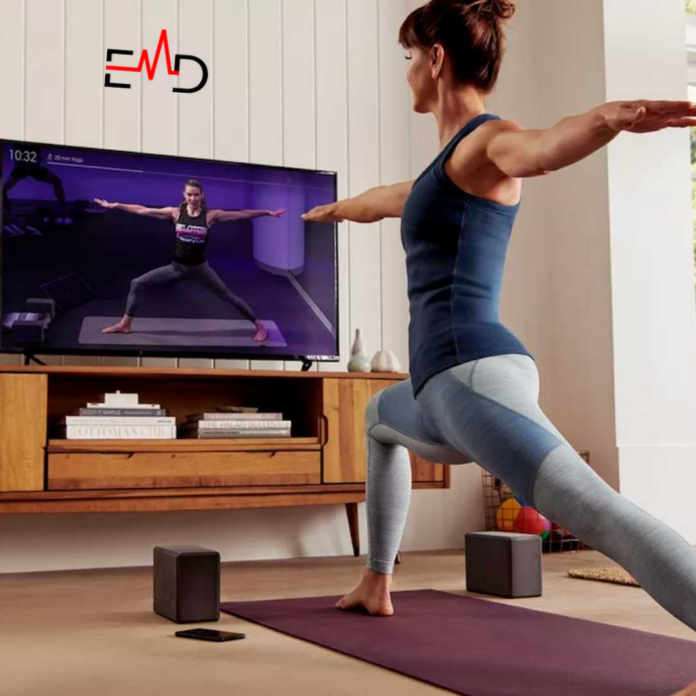Exercise Daily – The fitness industry has undergone a significant transformation in recent years, driven by the rapid advancement of technology. Technology has revolutionized how we exercise and track our progress, from fitness trackers and wearable devices to smartwatches, fitness apps, virtual reality (VR), and augmented reality (AR).
The Rise of Fitness Technology
Integrating technology into fitness has brought numerous benefits, making workouts more efficient, personalized, and engaging. Fitness trackers and wearable devices, such as Fitbits, Apple Watches, and Garmin devices, have become increasingly popular, providing real-time data on steps taken, calories burned, heart rate, and sleep patterns.
1. The Early Days: Pedometers and Heart Rate Monitors
The history of fitness technology can be traced back to the early 1960s when pedometers, simple devices that counted steps taken, were introduced. These devices, while basic, provided a rudimentary way to track physical activity.
In the 1970s, heart rate monitors emerged, allowing individuals to monitor their heart rate during exercise. This technology was initially used by athletes and fitness enthusiasts but eventually gained popularity among the general population.
2. The Fitness Tracker Revolution
The real game-changer in fitness technology came in the early 2000s with the introduction of fitness trackers. These devices, such as the Fitbit, offered a more comprehensive approach to fitness tracking, monitoring steps taken, calories burned, and sleep patterns.
Fitness trackers quickly gained popularity due to their ease of use, affordability, and ability to provide valuable insights into daily activity levels. They also helped raise awareness about the importance of physical activity and encouraged individuals to set and achieve fitness goals.
3. The Rise of Wearable Devices
The evolution of fitness technology continued with the rise of wearable devices, such as smartwatches and fitness bands. These devices offered more advanced features than traditional fitness trackers, including GPS tracking, heart rate monitoring, and the ability to track specific activities like running, cycling, and swimming.
Wearable devices also introduced the concept of notifications and reminders, helping users stay on track with their fitness goals and encouraging them to move more throughout the day.
4. The Future of Fitness Technology
The future of fitness technology holds exciting possibilities. Emerging trends such as artificial intelligence (AI), machine learning (ML), and virtual reality (VR) are poised to revolutionize the way we track and improve our fitness further.
AI and ML algorithms will be crucial in personalizing fitness experiences, providing tailored recommendations, and predicting injuries. VR technology will create immersive fitness experiences, making workouts more engaging and effective.

The Role of Technology in Fitness
Technology has played a pivotal role in changing the way we approach fitness. Fitness trackers and wearable devices have made tracking progress, setting goals, and staying motivated easier. Smartwatches and fitness apps offer personalized workouts and training plans tailored to individual fitness levels and goals. VR and AR technologies create immersive fitness experiences, making workouts more engaging and interactive.
Technology has transformed the fitness industry, pivotal in changing how we approach and achieve our fitness goals. Technology has revolutionized the fitness journey, from tracking progress and setting goals to providing motivation and accountability.
1. Tracking Progress and Setting Goals
Fitness technology allows us to track our progress and set realistic goals. Fitness trackers and wearable devices provide real-time data on steps taken, calories burned, heart rate, and sleep patterns, helping us assess our fitness levels and make informed decisions about our workouts.
We can identify areas to improve by tracking our progress and setting specific, achievable goals. This data-driven approach helps us stay focused and motivated, as we can see the tangible results of our efforts.
2. Motivation and Accountability
Technology provides a powerful tool for motivation and accountability. Fitness trackers and wearable devices offer progress updates and reminders, helping us stay on track with our fitness goals. They also allow us to connect with friends and family, share our progress, and compete in challenges.
This social aspect of fitness technology adds an extra layer of motivation and makes workouts more enjoyable. Knowing that others are supporting us and tracking their progress alongside us can help us stay committed and accountable.
3. Personalized Workouts and Training Plans
Fitness technology offers personalized workouts and training plans tailored to our fitness levels and goals. Smartwatches and fitness apps use algorithms to analyze our data and create customized workout plans that are both challenging and achievable.
These personalized workouts help us get the most out of our exercise routines and reduce the risk of injuries. They also save us time and effort by eliminating the need to design our workout plans.
4. Injury Prevention and Recovery
Technology can play a crucial role in injury prevention and recovery. Fitness trackers and wearable devices can monitor our heart rate and movement patterns, helping us identify potential risks and adjust our workouts accordingly.
Smartwatches and fitness apps offer guided recovery programs and exercises to help us recover from injuries and prevent future ones. Technology can help us stay safe and healthy while achieving our fitness goals by providing real-time feedback and tracking our progress.
5. Social Connectivity and Competition
Fitness technology fosters social connectivity and competition, making workouts more enjoyable and motivating. Smartwatches and fitness apps allow us to connect with friends and family, share our progress, and compete in challenges.
This social aspect of fitness technology can help us stay engaged and motivated as a community of like-minded individuals supports us on our fitness journey.

The Benefits of Using Fitness Technology
The benefits of using fitness technology are numerous. Fitness trackers and wearable devices help users track their progress, set goals, and stay motivated. Smartwatches and fitness apps provide personalized workouts and training plans, while VR and AR technologies create immersive fitness experiences.
1. Tracking Progress and Setting Goals
Fitness technology allows users to track their progress and set realistic goals. Users can assess their fitness levels and make informed decisions about their workouts by monitoring steps taken, calories burned, and heart rate.
2. Motivation and Accountability
Fitness technology provides motivation and accountability. Fitness trackers and wearable devices offer progress updates and reminders, helping users stay on track with their fitness goals. Smartwatches and fitness apps often include social features, allowing users to connect with friends and family for support and competition.
3. Personalized Workouts and Training Plans
Fitness technology offers personalized workouts and training plans tailored to individual fitness levels and goals. Smartwatches and fitness apps use algorithms to analyze user data and create customized workout plans that are both challenging and achievable.
4. Injury Prevention and Recovery
Fitness technology can help prevent injuries and aid in recovery. Fitness trackers and wearable devices can monitor heart rate and movement patterns, helping users identify potential risks and adjust their workouts accordingly. Smartwatches and fitness apps offer guided recovery programs and exercises to help users recover from injuries and prevent future ones.
5. Social Connectivity and Competition
Fitness technology fosters social connectivity and competition. Smartwatches and fitness apps allow users to connect with friends and family, share progress, and compete in challenges. This social aspect can add an extra layer of motivation and make workouts more enjoyable.

Fitness Technology for Athletes’ Performance
Fitness technology has become indispensable for athletes looking to optimize their performance and achieve their full potential. Technology is revolutionizing how athletes train and compete, from tracking and analyzing data to providing personalized feedback and training plans.
1. Tracking and Analyzing Performance Metrics
Fitness trackers and wearable devices allow athletes to track various performance metrics, including heart rate, speed, distance, and power output. This data can be analyzed to identify strengths and weaknesses, monitor progress, and make informed decisions about training and competition strategies.
2. Personalized Training Plans
Smartwatches and fitness apps use algorithms to analyze athletes’ data and create personalized training plans tailored to their needs and goals. These plans can include specific workouts, rest periods, and nutrition recommendations.
Personalized training plans help athletes optimize their training and reduce the risk of injuries. They also save athletes time and effort by eliminating the need to design their workout plans.
3. Real-Time Feedback and Coaching
Fitness technology can provide athletes with real-time feedback and coaching during their workouts. Smartwatches and fitness apps can offer audio cues, vibration alerts, and on-screen displays to guide athletes through their workouts and provide feedback on their performance.
This real-time feedback helps athletes stay focused and motivated and can also help them identify areas where they need to improve their technique or effort.
4. Injury Prevention and Recovery
Fitness technology can play a crucial role in injury prevention and recovery for athletes. Wearable devices can monitor an athlete’s heart rate and movement patterns, helping to identify potential risks and prevent injuries.
Smartwatches and fitness apps offer guided recovery programs and exercises to help athletes recover from injuries and prevent future ones. By providing real-time feedback and tracking progress, technology can help athletes stay safe and healthy while achieving their performance goals.
5. Performance Analysis and Optimization
Fitness technology allows athletes and coaches to analyze performance data and identify areas for improvement. By tracking key metrics over time, athletes can identify trends and patterns that can help them optimize their training and competition strategies.
Performance analysis can also help athletes identify and address weaknesses, such as imbalances in strength or flexibility. By addressing these weaknesses, athletes can improve their overall performance and reduce the risk of injuries.

The Future of Fitness Technology
The future of fitness technology holds exciting possibilities. Emerging trends such as artificial intelligence (AI), machine learning (ML), gamification, interactive workouts, wearable health sensors, biometric monitoring, smart gyms, and fitness studios are poised to revolutionize the fitness industry further.
1. Emerging Trends in Fitness Tech
Artificial Intelligence and Machine Learning
AI and ML algorithms will play a crucial role in personalizing fitness experiences. They will analyze user data to create tailored workout plans, predict injuries, and offer real-time feedback during workouts.
Gamification and Interactive Workouts
Gamification elements and interactive workouts will make fitness more engaging and enjoyable. To motivate users, fitness apps will incorporate game-like features, challenges, and rewards.
Wearable Health Sensors and Biometric Monitoring
Wearable health sensors and biometric monitoring will provide more comprehensive insights into users’ health and fitness. These sensors will track vital signs like blood pressure, oxygen levels, and muscle activity, allowing for personalized recommendations and injury prevention.
Smart Gyms and Fitness Studios
Smart gyms and fitness studios will offer immersive fitness experiences. They will use technology to track user progress, provide real-time feedback, and offer personalized workouts.
Conclusion
The future of fitness is undoubtedly tech-driven. Fitness technology will continue to evolve, offering new and innovative ways to track progress, stay motivated, and achieve fitness goals. We expect to see even more personalized, engaging, and effective fitness experiences as technology advances.
FAQs – How Fitness Technology is Redefining Your Fitness Journey
How can fitness technology help me achieve my fitness goals?
Fitness technology can help you achieve your fitness goals by tracking your progress, providing motivation and accountability, offering personalized workouts and training plans, preventing injuries, and fostering social connectivity and competition.
What are the most popular types of fitness technology?
The most popular types of fitness technology include fitness trackers and wearable devices, smartwatches, fitness apps, VR and AR technologies, smart gyms, and fitness studios.
How can I use fitness technology to stay motivated and accountable?
You can use fitness technology to stay motivated and accountable by setting goals, tracking your progress, connecting with friends and family, and participating in challenges.
What are the benefits of using fitness technology for injury prevention and recovery?
Fitness technology can help prevent injuries by monitoring heart rate and movement patterns. It can also aid in recovery by providing guided recovery programs and exercises.
What are some emerging trends in fitness technology that I should be aware of?
Some emerging trends in fitness technology include AI and ML, gamification and interactive workouts, wearable health sensors and biometric monitoring, and smart gyms and fitness studios.





